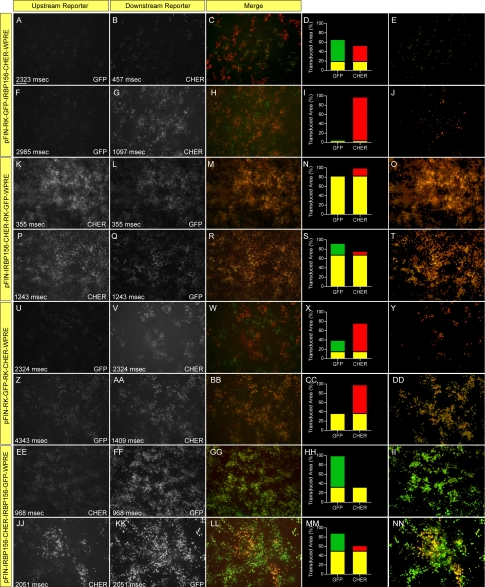Figure 5.
Expression characteristics of dual promoter vectors constructed using rhodopsin kinase (RK) and interphotorecepter binding protein (IRBP)156 promoters. pFIN-RK-GFP-IRBP156-CHER-WPRE (3.3×107 vector genomes/µl; A-E and F-J), pFIN-IRBP156-CHER-RK-GFP-WPRE (1.5×109 vector genomes/µl; K-O and P-T), pFIN-RK-GFP-RK-CHER-WPRE (1.85×107 vector genomes/µl; U-Y and Z-DD), or pFIN-IRBP156-CHER-IRBP156-GFP-WPRE (1.7×109 vector genomes/µl; EE-II and JJ-NN) lentivirus was injected into the developing neural tubes of E2 chicken embryos in ovo. A minimum of four retinal whole mounts were examined for each virus. Retinal regions shown in the figure were selected to illustrate the range of transgene expression characteristics observed in infected cells. Each region was photographed twice using the exposure duration shown in the lower left of each panel and filters appropriate for detection of CHER or GFP. Each row in the figure shows one selected region. The merged images (C, H, M, R, W, BB, GG, LL) were analyzed using the co-localization module of the Zeiss AxioVision Image Suite. The results of these analyses are expressed as the percent of the transduced area in the image (pixels) containing co-localized GFP and CHER (yellow bar) or GFP (green bar) or CHER (red bar) fluorescence alone. (D, I, N, S, X, CC, HH, MM). The images shown in E, J, O, T, Y, DD, II, NN were extracted from the merged images (C-LL) and show only those areas of the merged image in which GFP was co-localized with CHER. The scale bar shown in A is applicable to all images and equals 50 µm.

